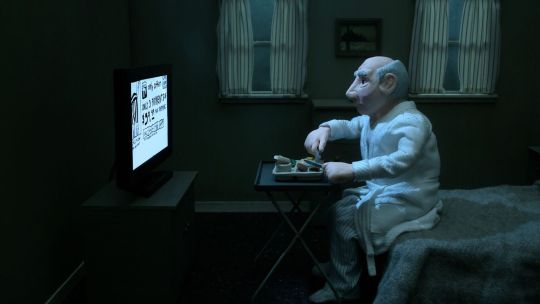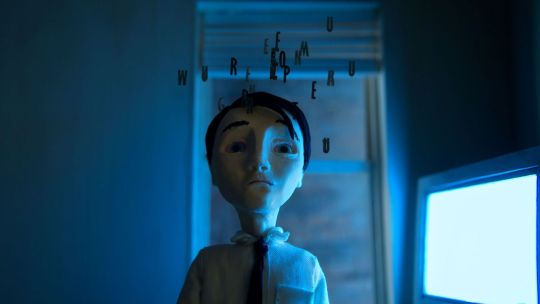Interview | Laura Naylor, Director of Fiscally-Sponsored Project“Bartleby”

The stop-motion film she created with co-director Kristen Kee is sweeping the festival circuit.
The meticulously made stop-motion film that took two years to complete, Laura Naylor’s and Kristen Kee’s reimagination of Herman Melville’s Bartleby, has finally hit the film festival circuit. Having already made appearances at the Aspen Film Shortsfest and the Seattle International Film Festival, Bartleby will share its animated magic with new audiences this summer at festivals including the Nantucket Film Festival, Melbourne International Animation Festival, and the Anima Mundi Festival in Brazil.
Based off of the classic story of a scrivener who punctuates the narrative with “I prefer not to,” Bartleby is re-set amongst protests on Wall Street, presenting itself as a powerful gesture or perhaps a refusal to life mired in the monotony of our modern-day work culture.
Director Laura Naylor gives us the scoop on her inclinations to move beyond office life, how “I prefer not to” became the antithesis for the commitments of the film process, ways to get film submissions noticed amidst festivals’ competitive shuffle, and how NYFA Fiscal Sponsorship helped with the project.
NYFA: What inspired you to create a film adaptation of Melville’s Bartleby the Scrivener? What makes the film different from the original story?
Laura Naylor: My co-director, Kristen Kee, and I first met in an office tower in midtown. We were both art school alums who had no business working in finance, but, like a lot of young artists, we needed day jobs to support our creative work. To cope with the monotony, we filled our days with schemes of making things together, which is how our plot to adapt Melville’s tale first hatched. Bartleby became an avatar who could “prefer not to” while we might still have to. Looking back it seems that in erecting a puppet office, in plotting Bartleby’s puppet escape, in devising his puppeted refusals, we were slowly making our own way out of that tall tower. And a few years after we did, we joined forces to bring our puppet pantomime to life. Unlike Melville’s Bartleby of 1853, our adaptation is set in the Wall Street of ~2011 amidst the tumult of protest and the isolating world of technological communications. Re-situated, this classic tale feels surprisingly timely.

NYFA: Before Bartleby, your film projects have been predominantly shot in a documentary vein, such as The Fix and Duck Beach. What made you decide to venture into fiction and stop-motion filmmaking?
LN: In my first feature documentary, Duck Beach, I created a stop-motion sequence and loved the process so much I promised myself I’d re-engage with the medium at some point. And I’d always wanted to find a way to work with Kristen, who studied sculpture at Yale. Stop motion seemed to be the perfect meeting point to equally leverage my film background with her sculpture expertise. And the process was antithetical to documentary filmmaking in a way that felt terrifyingly tempting: documentaries are strung together in the editing room, where piles of footage are culled, cut, and moved about like a game of musical chairs in order to create a cohesive narrative. With stop-motion animation, every single nitty-gritty detail must be meticulously mapped out in advance. This felt like a thrilling invitation to stretch my creative muscles.
Plus, I enjoyed the tension between narrative and medium: the star of our story deteriorates (or evolves) into a state of preferring not to do anything at all, whereas stop motion requires a continuous, labor-intensive opting in. And perhaps most importantly, stop motion afforded us the freedom to construct entirely new worlds (with their own visual language, creatures, and rules) to cinematize a diaristic narrative where the action is played out mostly inside the narrator’s head.
NYFA: Bartleby is visually stunning and it’s evident that it required a very intricate and detailed process. How long did it take to complete? During production, did you face any challenges along the way?
LN: Two years! We finished the script in mid-2015, and, after assembling our team, spent the fall fabricating and building all of our puppets, props, and sets. We shot in a warehouse in Brooklyn for the first six months of 2016, and then spent the second half doing post-production (letter animation, editing, music composition, sound design, and color grading). Stop motion is two things (among other things): risky and challenging, and neither Kristen or I had ever attempted it on this scale before. There was a steep learning curve, and even when we were up and running, every ~8 second shot (which took an entire day to shoot) was rife with risks—that we’d bump the table and have to start the shot all over, for example—and the challenge of laboring day after day in a windowless room.

NYFA: Every film has many moving parts. In Bartleby’s case, it required clay sculptures, paper figures, special lighting and animation, and nearly 20,000 photographs to culminate into an 11-minute film. Can you tell us a little bit about the team behind Bartleby? How did they get involved in the project?
LN: Because our hiring process couldn’t involve tempting people with attractive day rates, we focused on creating a family of artists who were all fired up about our vision. And then we allowed them the space to really go nuts creatively and explore. We had a costume designer (Emily Geanacopoulos) who was creating clothes for miniature puppets for the very first time, and musicians (Bright & Guilty) who were stop-motion super fans as kids and came to the table with a host of their own superbly wacky ideas. Our art director and animator (Josh Mahan) is a stop-motion magician and helped us build Bartleby’s physical world, and then brought it to life with his skillful and soulful animation. Our DP (Zach Poots) spent months in that dark windowless room wrangling miniature lights to create the cinematic lighting environment for the nearly 20,000 photographs that make up the film. Each person we found through word of mouth, seeking out other creatives nuts enough to make stop-motion magic with us. We couldn’t have made the film without them, and we’re proud of the family we built.
NYFA: Bartleby has been extremely successful in the film festival circuit this spring and summer—it has already been shown at Aspen Film Festival and the Seattle International Film Festival and will be making its way to Palm Springs Shorfest and Nantucket Film Festival, among others. Do you have any advice for filmmakers who are trying to get their submission in the door?
LN: The festival circuit can seem daunting (and expensive) for independent filmmakers trying to break in. We were lucky enough to premiere at one of the world’s top shortsfests (Aspen), which put us on the radar for other festivals. My strategy has always been to start by targeting a few top festivals that seem like a match for the film (knowing what kinds of films are usually programmed definitely helps) and then holding out for a solid premiere instead of casting a wide net and going with whoever bites first. One thing to remember is that festivals get thousands of submissions, which result in way more superb films than they can possibly program, so advocating for your film after you submit can elevate its spot in the pile.
NYFA: Why did you choose NYFA Fiscal Sponsorship?
LN: The program has enabled me to apply for and accept funding for my projects (as part of an umbrella 501©(3)) that I otherwise wouldn’t have had access to. As a fiscally sponsored artist, I’m also eligible to apply for specific NYFA grants, such as the Opportunity Grant, which I was awarded last year for Bartleby.
NYFA provides additional administrative support such as vendor payments and tax form generation, which was an enormous help on a project like Bartleby that involved so many independent contractors. And it’s always motivating to have a team of people rooting for you along the way.
Upcoming Bartleby Screenings
Where: Melbourne International Animation Festival
Date and Time: Monday, June 19, 2017, 5:15 PM
Location: Australian Center for the Moving Image, Federation Square, Flinders Street, Melbourne VIC 3000, Australia
Tickets: $12, available for purchase here
Where: Palm Springs International Shortfest
Date and Time: June 21, 2017, 2:00 PM
Location: Camelot Theatres, 2300 E. Baristo Road, Palm Springs, CA 92262
Tickets: here, public sales begin June 14, 2017
Where: Nantucket Film Festival – Animated Shorts
Date and Time: June 25, 2017, 9:00 AM
Location: Bennett Hall, 62 Centre Street, Nantucket, MA 02554
Tickets: $15, available for purchase here
Where: Anima Mundi
When: Festival runs July 18-23, 2017
Location: Rio De Janeiro, Brazil
More Details: To be announced
Laura Naylor (Writer/Director/Producer) fell for images, moving and not-so-mobile, while studying art at Columbia. Her directorial debut, Duck Beach—a feature documentary about Mormon singles trying to tie-the knot—premiered at the Seattle International Film Festival and aired on BBC 3 in the UK. Her second feature, The Fix, premiered at AFI Docs, won the jury prize for “Best Documentary” at the Soho International Film Festival, and was hailed a “poignant portrait of life in recovery” by The Hollywood Reporter. After animating a stop-motion sequence for one of her docs, she said “YES PLEASE” to creating tiny worlds.
Kristen Kee (Writer/Director/Illustrator) is an artist who makes neon sculptures and jargon paintings and exhibits them around the world. She has a degree in Sculpture from Yale and studied neon and glass-making at Pilchuck Glass School. Prior to Bartleby, she directed and designed several stop-motion shorts —including Grapefruit, wherein dried grapefruit halves act out Yoko Ono’s book —and has been sculpting Bartleby-like characters since middle school. Her latest series of jargon paintings feature the rants of our current President. She lives and works in Brooklyn alongside her partner Taryn and their dog Butter.
Interview conducted by Priscilla Son, Program Assistant, Fiscal Sponsorship & Finance
NYFA Fiscal Sponsorship’s next quarterly no-fee application deadline is June 30, and you can learn more about NYFA’s Fiscal Sponsorship program here. Read about other exciting projects utilizing sponsorship in our NYFA Fiscal Sponsorship Directory.
Images: Group Photo, Photo Credit: Anthony Johnson; Film stills, Photo Credit By the By Productions





